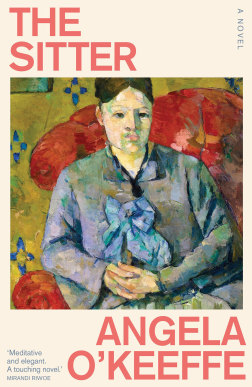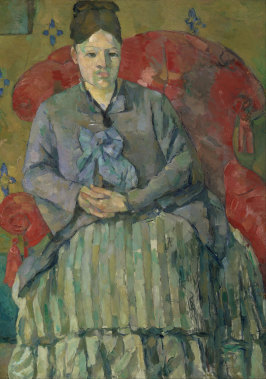By Fiona Gruber
FICTION
The Sitter
Angela O’Keeffe
UQP, $29.99
Marie-Hortense Fiquet Cezanne has never had a good press. The wife of the French painter was labelled a drunk, a gambler, mean-spirited, selfish, dull, a bit common and not particularly attractive. According to one story, when her husband was dying in October 1906, she decided to keep an appointment with her dressmaker instead of hurrying to his bedside.
And yet, if she had been in charge of the narrative, would Paul Cezanne have come off any better? The couple’s life was riven with subterfuge as Cezanne kept his liaison a secret from his prosperous and disapproving family.

Angela O’Keeffe’s novel gives voice to the put-upon wife of Paul Cezanne, Hortense.Credit: Camille Walsh
He would leave Hortense (as she was known) and their young child Paul in Paris, returning to the south to paint for months on end. When they finally married 17 years after meeting, it seems to have been mainly to legitimise their son. His friends derisively called Hortense “la boule”, the ball, a reference to her full figure, and when he died it was discovered that Cezanne had cut her out of his will.

The Sitter is Angela O’Keeffe’s second novel.Credit:
In Night Blue, Angela O’Keeffe’s debut novel, she gave Jackson Pollock’s Blue poles consciousness, a voice and a sensuality; the painting and its pigments became a character in the novel alongside the artist.
In her second novel, The Sitter, it is Hortense, the subject of many paintings, who comes to life. One in particular, Madame Cezanne in a Red Armchair, painted in 1877, weaves through the narrative, one of 29 studies Cezanne made of her over nearly 40 years.
At the start of the story Hortense, who died in 1922, swims back into consciousness and finds herself in a gallery in front of the painting. Within its frame, she recognises the light-blue jacket with its floppy bow, the dark, neatly parted hair, and her inward-looking, inscrutable expression, a solemn unwillingness to engage which is a hallmark of all the portraits.
In none of them does she smile. But this is not to say she was not a smiler; as she remarks, being a sitter is backbreaking work. Cezanne painted her face as it would have been in repose; patient, preoccupied and often bored rigid as her husband paused, seemingly interminably – he could spend 20 minutes between strokes – pondering how to imbue pigment with feeling.
“I paint a head like a door” wrote Cezanne, implying that for him the essence of both was equally important, and a human being was a series of shapes, as was a portal or a row of trees. But he also said that if he couldn’t find a feeling for any part of a subject, he would leave that section of the painting blank.

Madame Cezanne in a Red Armchair, by Paul Cezanne (1877).Credit: Museum of Fine Arts Boston
“In the portraits of me there are many blanks,” says O’Keeffe’s Hortense.
We discover that Cezanne’s not-quite muse is eager to fill in those blanks, and her confessor is the woman who is writing about her, an unnamed Sydney-based novelist. It is March 2020, and they find themselves tethered together in a hotel room in Paris. They are in a city in lockdown, swimming in and out of focus, warping the edges of each other’s minds, in a novel that often reads like a lucid dream.
An accident witnessed from their hotel window becomes a pivotal point in the narrative when the gaze of the writer switches to her own history, a story that Hortense, liberated from being the subject, also pursues.
Both The Sitter and Night Blue aim to get under the skin of what it is to create and inhabit a work of art, to be a space that exists both in the imagination and on a canvas or a page.
There’s a philosophical framework to the novel too, in The Poetics of Space (1958) by the French philosopher Gaston Bachelard. This influential work on architecture and art explores the way imagination and emotion are as important as design in how we negotiate and feel about the places we dwell in.
“Inhabited space transcends geometrical space,” he wrote, an insight that would have chimed with Cezanne, but it is another observation by Bachelard, “shade, too, can be inhabited”, that frames the novel and gives a sense of focus to a satisfyingly provocative and elusive piece of writing.
The Booklist is a weekly newsletter for book lovers from books editor Jason Steger. Get it delivered every Friday.